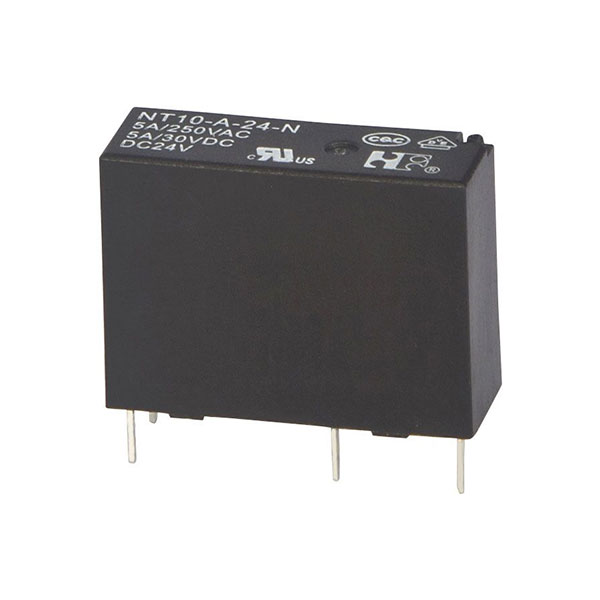Key Considerations for Choosing the Right Slim PCB Power Relay
2024-07-10
Introduction
Selecting the right relay for your electronic design can be a critical decision that impacts the overall performance and reliability of your project. Slim PCB power relays, with their compact design and high power handling capabilities, are an excellent choice for many applications. However, choosing the right slim PCB power relay requires careful consideration of several factors. This blog will discuss the key considerations for selecting the most suitable slim PCB power relay for your needs.
Key Considerations for Choosing Slim PCB Power Relays
1. Electrical Specifications
- Coil Voltage: Determine the operating voltage of the relay coil. Slim PCB power relays are available with various coil voltage ratings, such as 5V, 12V, or 24V, to match your circuit requirements.
- Contact Rating: Assess the maximum current and voltage that the relay contacts can handle. Ensure the relay can manage the load requirements of your application.
2. Physical Size and Mounting
- PCB Footprint: Consider the available space on your PCB. Slim PCB power relays come in various sizes, so choose one that fits within your design constraints.
- Mounting Style: Ensure the relay is compatible with your PCB mounting style, whether it’s through-hole or surface-mount.
3. Switching Performance
- Switching Speed: Evaluate the relay’s switching speed, especially if your application involves high-frequency switching.
- Contact Configuration: Decide on the contact configuration needed for your application, such as single pole single throw (SPST), single pole double throw (SPDT), or double pole double throw (DPDT).
4. Durability and Reliability
- Mechanical Life: Check the relay’s mechanical life, typically measured in millions of operations, to ensure it meets the longevity requirements of your application.
- Electrical Life: Consider the relay’s electrical life, which indicates how long it can reliably switch electrical loads without failure.
5. Environmental Considerations
- Operating Temperature Range: Ensure the relay can operate within the temperature range of your application environment.
- Sealing and Protection: For applications exposed to harsh environments, choose relays with appropriate sealing and protection ratings, such as IP ratings.
Additional Features to Look For
1. Energy Efficiency
- Low Coil Power Consumption: Select relays with low coil power consumption to enhance the energy efficiency of your design.
- Thermal Management: Consider relays with efficient thermal management to minimize heat generation and maintain optimal performance.
2. Compliance and Standards
- Certifications: Check for industry certifications and standards compliance, such as UL, IEC, or RoHS, to ensure the relay meets safety and environmental regulations.
- Quality Assurance: Choose relays from reputable manufacturers with stringent quality control processes to ensure reliable performance.
3. Customization Options
- Tailored Solutions: Some manufacturers offer customization options for slim PCB power relays, allowing you to tailor the relay specifications to your specific application requirements.
- Technical Support: Consider manufacturers that provide robust technical support and design assistance to help you select and integrate the right relay.
Examples of Slim PCB Power Relay Applications
1. Smart Home Devices
- Lighting Control: Used in smart lighting systems to switch lights on and off remotely.
- Home Security: Integrated into security systems for controlling door locks, alarms, and surveillance cameras.
2. Medical Equipment
- Patient Monitoring Systems: Employed in medical devices for reliable and safe power switching in patient monitoring systems.
- Diagnostic Equipment: Used in diagnostic machines to control various functions and ensure accurate results.
3. Renewable Energy Systems
- Solar Inverters: Utilized in solar power systems to manage the connection and disconnection of solar panels and batteries.
- Wind Turbines: Integrated into wind turbine control systems for efficient power management and safety.
4. Telecommunications
- Base Stations: Used in telecommunications base stations for managing power distribution and signal routing.
- Network Infrastructure: Integrated into network infrastructure equipment to ensure reliable operation and connectivity.
Conclusion
Choosing the right slim PCB power relay involves careful consideration of electrical specifications, physical size, switching performance, durability, and environmental factors. By understanding these key considerations and evaluating additional features, you can select the most suitable relay for your application, ensuring optimal performance and reliability. Slim PCB power relays are versatile and efficient components that, when chosen correctly, can significantly enhance the functionality and safety of your electronic designs.



